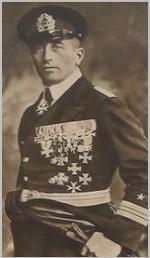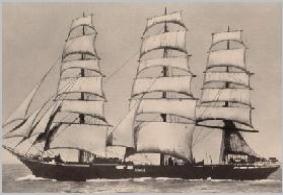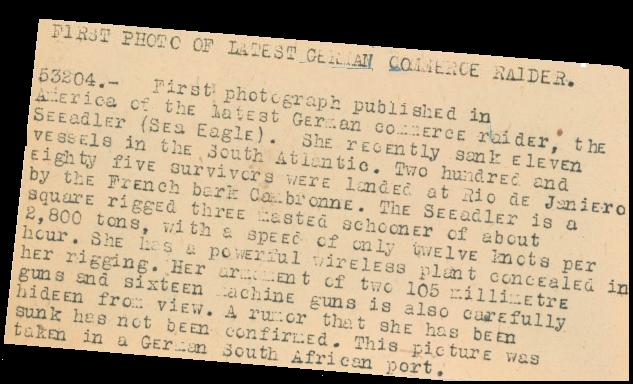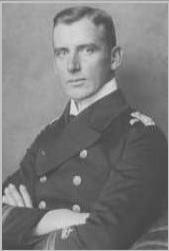

Felix Graf von Luckner was born in Dresden on June 9, 1881 and was quite an adventurer. He had ran away from home at age thirteen to see a Buffalo Bill show, then signed up as an unpaid cabin boy on a Russian sailing ship under the assumed name of “Phylax Lüdecke.” He jumped ship in Australia and spent seven years doing an assortment of things to get by, from being a kangaroo hunter to a professional boxer.
Exceptionally strong, Luckner was noted for his ability to bend coins between his fingers and to tear up telephone directories with his bare hands. He was also a railway worker, a bartender, a fisherman and even a guard in the Mexican army. He traveled widely and spent some time in jail in both Chili and Jamaica. Luckner was also a talented magician who was often invited to entertain the Kaiser and his guests. He enrolled in a German navigation training school at age twenty and passed the examinations for his mate’s commission. He volunteered service to the Imperial Navy and he took part in the Battle of Heligoland Bight, and during the Battle of Jutland he commanded a gun turret aboard the battleship Kronprinz Wilhelm.
In order to combat the lethal British blockade, Germany had converted several merchant ships into raiders by equipping them with guns and sending them in search of Allied merchant ships, but by 1915 most of the armed raiders had been sunk or interned. Germany could not send out any of the German Grand Fleet as they were involved in a stand off with British and French fleets, and they could not afford to lose any more ships. All the Germans had left to commission was a 245-foot, full-rigged, Scottish-built three masted wooden bark built in 1888 that the Germans had captured off of Norway. It was close to the end of its life and needed a total rehaul. She was renamed “Seeadler” and she would find herself a perfect captain: the ten year veteran of sailing ships with an outstanding record in the German Navy, colorful aristocrat Count Felix Von Luckner. As virtually the only officer in the German Navy with extensive experience of large sailing ships, Luckner was appointed commander of the impounded ship. The problem was how to get it through the tight British blockade.
The Seeadler, with its bogus name “Irma” and a load of timber supposedly bound for Australia, carried false papers and a pilfered log book when it quietly slipped out of the river Weser on December 21, 1916 and skirted up the Norwegian coast to sneak around the tip of Northern Scotland where it could break free into the Atlantic. Many of the crew of 6 officers and 57 men on the “Irma” were chosen for their ability to speak Norwegian, as could the captain, in case of British interception.
As part of the pretense, von Luckner had a thin young sailor ready to wear a blonde wig and masquerade as his wife. The Seeadler had only two obsolete cannons and a few rifles for protection when she sailed straight into one of the worst hurricanes that had hit the North Sea in a long time. As Luck(ner) would have it, the hurricane was more of a blessing than a curse. Although Von Luckner, running the frozen ship with the wind, was being pushed dangerously North toward the arctic ice, the storm had dispersed the British blockade and forced their ships back to port. In the nick of time, the winds died down and the crew was able to free the ice from the blocks and the running rigging could finally be used to change sail. The Seeadler sailed toward calmer seas.
After a close call with a boarding party from an armed British merchant cruiser, Von Luckner was cleared to proceed, and on Jan 9, 1917 the Count captured his first vessel, the steamship Gladys Royal, who was carrying 5,000 tons of coal. The entire crew of captured sailors were taken safely aboard the Seeadler while the Gladys Royal was sent to the bottom of the sea. In the next thirty thousand miles of sailing, Von Luckner sunk 14 ships and would never allow any of the crew of his captured vessels to drown. He not only allowed the captured sailors to live, he treated them with the utmost respect and courtesy. They were well-fed, well-berthed and allowed recreation on deck while their Captains dined daily with Von Luckner at the Captain’s table.
About the time the Seeadler’s prisoners’ quarters were bursting at the seams from his generosity, Von Luckner captured a French bark, the Cambronne, which was well stocked with provisions. He extracted a promise from his prisoners that if he let them have the Cambronne, albeit with much-reduced rigging to slow it down, they would not try to converse with any ships and would sail directly to the nearest port, Rio de Janeiro, thus allowing the Seeadler time to make her getaway. He then treated the departing Captains, under the command of Captain Mullen of the Pinmore, to a banquet, and with his own money he paid every captured seaman the same wages they would have earned otherwise during their time of captivity. They sailed off to freedom and all of them kept the promise. The notorious Count was from that time forward given the name “The Sea Devil.” The news report that it had been sunk was inaccurate. Below: Luckner, his ship and an original press photo of the ship and its caption.

|

|


Luckner decided to sail with five of his men in one of the small open boats which he rigged as a sloop and named the Kronprinzessin Cecilie. He intended to sail to Fiji and capture a sailing ship, then return to Mopelia for his crew and prisoners. After pretending to be Dutch-Americans or Norwegians to get supplies along the way, von Luckner’s party made it to the island of Wakaya after a 3,700 km voyage in an open boat. When the local police threatened the party, Luckner, wishing to avoid bloodshed (and not realizing that the police were unarmed), surrendered and they were confined in a prisoner-of-war camp on an island off of Auckland.
Back on Mopelia, Leutnant Kling of the Seeadler heard of von Luckner’s capture on the radio, and sailed out and captured a French ship in the harbor, the Lutece, at gunpoint. He put the French crew ashore with the other prisoners, and he and all of the Germans set sail for South America in the ship they renamed the Fortuna. Unfortunately for the crew of the Fortuna, they struck uncharted rocks off of Easter Island and when they went ashore they were interned by the Chileans for the remainder of the war.
Meanwhile, in December of 1917, Luckner and some other prisoners seized the prison camp commander’s motor boat and escaped from their island prison, later seizing a 90 ton scow named the Moa. He was on the run for a year before he was caught and imprisoned for the remainder of the war in various POW camps in New Zealand before returning to Germany in 1919.
The Seeadler had successfully sunk 50,000 tons in her short career. Every man of the crew eventually returned home to Germany. Von Luckner had lost not one of his own crew or any of those captured throughout his many raids. After the war, Von Luckner authored a book of his adventures and traveled extensively, lecturing and teaching in the United States and England. Many cities in the United States made him an honorary citizen. In 1937 and 1938, he and his wife undertook a round-the-world voyage in his yacht and were largely welcomed in New Zealand and Australia.*
At the end of the Second World War, he was living in Halle with his wife and mother when the mayor asked him to negotiate the town’s surrender to the approaching American forces, which he did, although he did not return to the town. Luckner moved to Sweden with his second wife where he lived until his death in 1966. He is buried in Hamburg.
* Luckners’ personal yacht, also named the Seeteufel, was taken by Russia after World War Two.The Seeadler and, as you will read of next, Emden had great psychological impact when their strict adherence to the laws of war resulted in stories being circulated of their chivalrous behavior which stood in marked contrast to the propaganda showing the Kaiser’s men skewering Belgian babies. They were also a huge embarrassment to a navy which considered itself the greatest in the world and all but invincible.

|

|
But Emden was as dangerous as she was an embarrassment to the British, and in the second half of 1914, Emden had sunk or captured thirty Allied merchant vessels and warships in the Indian Ocean, at one point sinking six British ships within one week, and eleven within one month for a total of 50,000 tons. By 1914, while no fewer than sixty Allied warships were frantically searching for Emden in the Indian Ocean, von Müller decided to send a 50 man landing party ashore at Direction Island on November 9th to destroy the British communications station’s radio tower and equipment. The British civilians did not resist the courteous landing party.. they knew that a call for help had already been radioed. The Australian cruiser HMAS Sydney with heavier guns than Emden was only 50 miles distant and she was dispatched and due to arrive in two hours. When Von Müller spotted the Sydney, he had no option other than raising anchor to engage the enemy ship, reluctantly leaving his landing party stranded on Direction Island. Guns blazed for nearly ninety minutes and Emden incurred significant damage. Struck over 100 times by shells, von Müller beached Emden on North Keeling Island to avoid sinking.

The only men to escape were the landing party on shore. Witnessing Emden’s sorry fate, they commandeered an old sailing schooner and quietly slipped away, commanded by Müller’s executive officer Kapitanleutnant von Mucke who would later recount their adventures as an author and lecturer. They took a remarkable 1,700 kilometres ocean journey to Padang where they abandoned the unstable stolen Schooner and, disguising themselves as Italian merchantmen, continued in a German ship, the SS Choising. They then sailed to the Red Sea, landing near Yemen. After a skirmish with Bedouin tribesmen, they were escorted into Hodieda by Turkish troops. At this point they used horses and mules to proceed up the Arabian Peninsula, but were forced back into Yemen.
They commandeered two crafts called “zambucks,” one of which sunk, all the while eluding capture by both British and French forces. When they next landed, they traveled to Djeddah on camels and one of the party was killed by a Bedouin. Granted the right to travel through Syria by the Emir of Mecca, the 5 officers, 7 petty officers and 30 men finally reached Constantinople in June, 4,300 miles from their departure point at Direction Island. The German government allowed all of the surviving officers and men to permanently add the suffix ‘Emden’ to their surnames as an honor.
Unlike Count Von Luckner, Karl von Müller lived quietly after the war and declined most invitations to speak until his death in 1923. When he was once asked why he did not write a memoir, Müller replied, “I should not be able to escape the feeling that I was coining money from the blood of my comrades.”